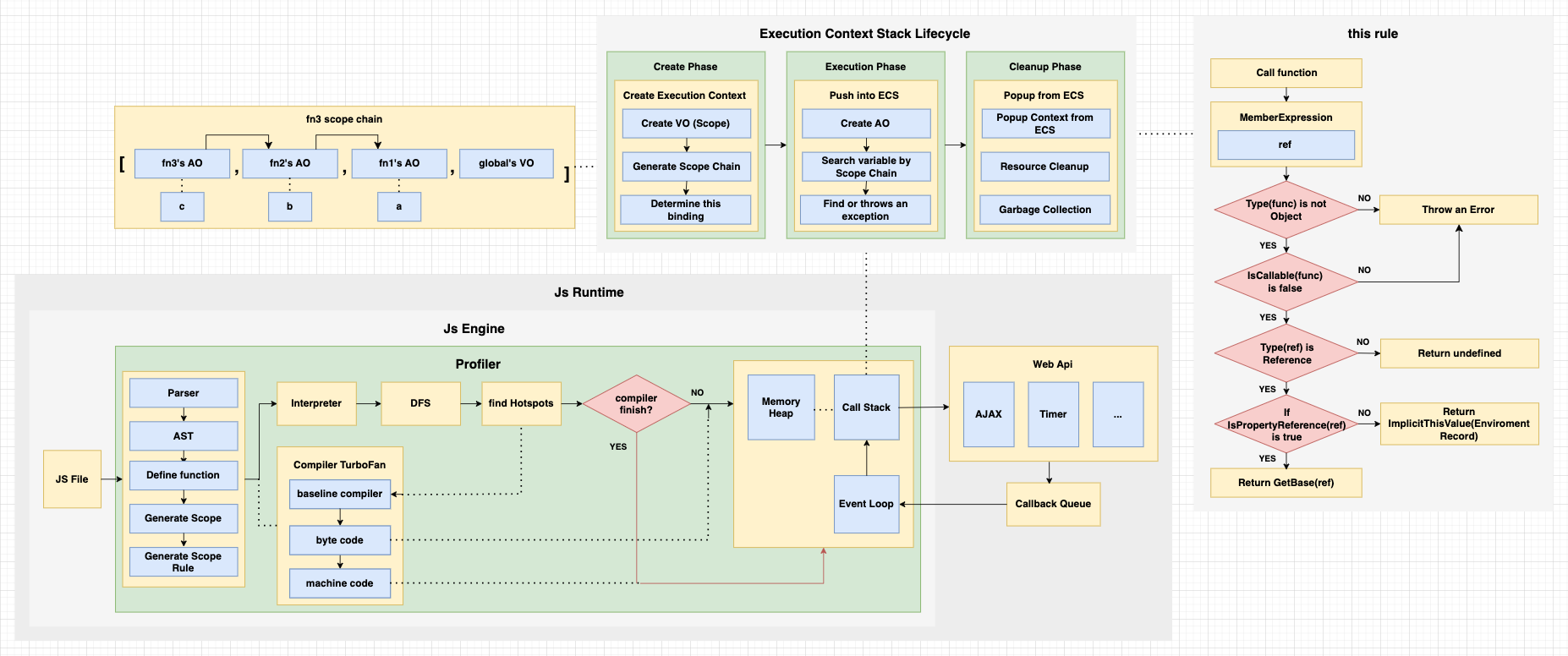重新認識 Javascript(五)- this
前言
前面說了這麼多,總算輪到我們心心念念的 this 了,在正式解釋之前,我們一定要銘記:
-
變量的引用是在變量
被創建時決定的。let Name = "Potter"; function getName() { console.log(Name); } function getPerson() { let Name = "Ronald"; getName(); } getPerson(); // Potter
-
this 值是在 this
被調用時決定。const person = { Name: "Potter", getName: function () { console.log(this.Name); }, }; const getName = person.getName; person.getName(); // Potter getName(); // undefined
很多時候會誤判 this 都是因為錯誤的調用時機所引起的。
函式取 this 值規則
this 可以簡單理解成用來說明是誰在使用某函式的方式。如果函式被物件使用,this 就指向這個物件;如果函式被獨立使用,this 就指向全域。之所以會有這個情況發生,就要來說說 ECMAScript標準11.2.3 的 取值規則:
1. Let ref be the result of evaluating `MemberExpression`.
2. Let func be `GetValue`(ref).
3. Let argList be the result of evaluating Arguments, producing an internal list of argument values.
4. If `Type`(func) is not Object, throw a TypeError exception.
5. If `IsCallable`(func) is false, throw a TypeError exception.
6. If `Type`(ref) is `Reference`, then
a. If `IsPropertyReference`(ref) is true, then
i. Let thisValue be `GetBase`(ref).
b. Else, the base of ref is an `Environment Record`
i. Let thisValue be the result of calling the `ImplicitThisValue` concrete method of
`GetBase`(ref).
7. Else, `Type`(ref) is not Reference.
a. Let thisValue be undefined.
8. Return the result of calling the [[Call]] internal method on func, providing thisValue as the
this value and providing the list argList as the argument values.
其中 6.、7. 是拿到 thisValue 的關鍵,但為了更好地理解以上內容,會先簡述上面提及的關鍵詞:
-
MemberExpression:描述如何訪問對象的屬性或方法。在 AST Explorer 輸入以下:
person.name; person["name"]; person.getName();可以看到三行程式碼對應的 AST Tree 都有
MemberExpression並都包含兩個關鍵屬性:object、property,分別表示.之前的物件和之後的屬性。MemberExpression ├─ object: Identifier (name: "person") └─ property: Identifier (name: "getName")這裡值得一提的是:
getName();雖然在 AST Tree 中僅表示
CallExpression,但 getName 也是MemberExpression的一部份,因為 getName 表示要存取的函式或表達式。 -
ref:是一個抽象概念,是
MemberExpression的代替詞,方便後續說明。 -
func:代表要執行的函式或方法,需透過 GetValue(ref) 取得。
-
GetValue:取得變數或屬性的實際值。
-
Type:用於確定值的類型,如:數字、字串、物件…等。
-
IsCallable:檢查一個值是否可以被呼叫。
-
Reference:這裡用來判斷
Type(ref)是否為引用類型。在 ECMAScript 中為方便說明,由三部分組成:let person = {name: 'Potter'} person.name's Reference: { baseValue: person, // 指向引用的原對象 referencedName: name, // 引用的名稱 strictReferenceFlag: false // 標示是否嚴格模式 }let school = 'Hogwarts' school's Reference: { baseValue: EnvironmentRecord, // 指向引用的原對象 referencedName: school, // 引用的名稱 strictReferenceFlag: false // 標示是否嚴格模式 } -
IsPropertyReference:用於檢查 Reference 是否引用了一個物件的屬性。
let person = { name: "Potter" }; person.name; // IsPropertyReference === true -
GetBase:取得 Reference 的
baseValue,也就是當前 ref 引用的原對象。 -
Environment Record:用於存放
標識符<->變量的映射表。可參考 創建階段 - 環境紀錄 -
ImplicitThisValue:根據 Reference 的 baseValue 找出 this 值。
配合以上關鍵詞,我們可以將上面 6.、7. 的內容精簡成:
- 若 ref 的類型是 Reference,且 Reference 是引用了一個對象的屬性,那 thisValue 就等於 ref 的 Reference 的 baseValue。
- 若 ref 的類型是 Reference,且 Reference 的 baseValue 等於 Environment Record,那 thisValue 就等於 ImplicitThisValue(ref 的 Reference 的 baseValue)。
- 若 ref 的類型不是 Reference,那 thisValue 等於 undefined。
一般函式
接著讓我們回頭看看 前文 提及的:
const person = {
Name: "Potter",
getName: function () {
console.log(this.Name);
},
};
const getName = person.getName;
person.getName(); // Potter
getName(); // undefined
並各別解釋。
person.getName()
- 此時
MemberExpression等於 person.getName,而ref用來代表 person.getName 這個表達式。 - 透過
GetValue取得ref要實際呼叫的函式getName,並以func表示。 - 沒有傳遞參數,所以 argList 為空。
func等於 person.getName 的 getName,是函式物件,所以不報錯。func是函式物件,可以呼叫,所以不報錯。- 因為引用了一個函式,所以
Type(ref)是Reference,如下:Reference: { baseValue: person, // 指向引用的原對象 referencedName: getName, // 引用的名稱 strictReferenceFlag: false // 標示是否嚴格模式 } - 因為引用的是物件屬性,所以
IsPropertyReference(ref)是 true。 - 回傳
GetBase(ref)也就是 person。
所以 person.getName() 內部的 this 會指向 person,而 person.Name: Potter,最終輸出 Potter。
getName()
- 此時
MemberExpression等於 getName,而ref用來代表 getName 這個表達式。 - 透過
GetValue取得 ref 要實際呼叫的函式getName,並以func表示。 - 沒有傳遞參數,所以 argList 為空。
func等於 getName,是函式物件,所以不報錯。func是函式物件,可以呼叫,所以不報錯。- 因為引用了一個函式,所以
Type(ref)是Reference,如下:Reference: { baseValue: Environment Record, // 指向引用的原對象 referencedName: getName, // 引用的名稱 strictReferenceFlag: false // 標示是否嚴格模式 } - 因為引用的是 Environment Record,所以
IsPropertyReference(ref)是 false。 - 回傳
ImplicitThisValue(ref's Reference's baseValue)。
所以 getName() 內部的 this 會指向 Environment Record,而 Environment Record 並不存在 Name,最終輸出 undefined。
總結
根據 ECMAScript標準10.4.3 的說明,在非嚴格模式下,當 thisValue 等於 null 或 undefined 時會自動綁定全局物件 window。
因此大部分情況下我們可以通過 MemberExpression 判別 this 指向,若 MemberExpression 有 object,this 就指向 object,沒有就指向 window。
箭頭函式
箭頭函式比起一般函式有兩個不同的地方:
- 自身沒有 this,完全根據父層作用域決定 this,並且無法透過 bind、call 或 apply 等方式改變 this 指向。
- this 總是指向定義時所在的上下文。
如以下程式碼:
const person = {
Name: "Potter",
age: 18,
getName: function () {
return () => {
console.log(this.Name);
};
},
getAge: () => {
console.log(this.age);
},
};
const getName = person.getName();
const school = { Name: "Hogwarts", getName };
getName(); // Potter
school.getName(); // Potter
person.getAge(); // undefined
person.getName()傳回箭頭函式並賦值給getName。在呼叫時箭頭函式就已經將 this 綁定到 person,所以getName回傳 Potter。school.getName()由於箭頭函式的特性,this 總是指向定義時的上下文,所以也回傳 Potter。person.getAge()雖然MemberExpression有 object,但由於箭頭函式的特性,它會根據父層作用域來確定 this,即 window,而 window 並沒有 age 屬性,所以回傳 undefined。
new
此部份可參考上篇文章 原型鏈 - new 中了解到實例化步驟,構造函式內部的 this 會綁定到新創建的對象上。因此自然地 this 就指向新創建的對象。
如以下程式碼:
function Person(name) {
this.name = name;
}
const person1 = new Person("Potter");
const person2 = new Person("Ronald");
person1.name; // Potter
person2.name; // Ronald
call、apply、bind
對於 this 而言,這三者均能做到同件事,就是顯性地更改函式內 this 的指向。根據 MDN 讓我們看看這三者各自的語法:
fun.call(thisArg[, arg1[, arg2[, ...]]])
fun.apply(thisArg, [argsArray])
fun.bind(thisArg[, arg1[, arg2[, ...]]])
雖然 call 和 bind 的語法幾乎一樣,但從功能上我們反而是將 call 和 apply 歸為一組,這是因為:
call和apply都是更改this的指向後,直接調用。bind是更改this的指向後,返回函式供使用者調用。
用法
讓我們再次使用前言的範例進行說明:
const person = {
Name: "Potter",
getName: function (name) {
console.log(`I'm ${this.Name}. Hi, ${name}`);
},
};
const getName = person.getName;
getName("Ronale"); // I'm undefined. Hi, Ronale
1. call
第一個參數為 this 更改後的指向,接下來的參數會被傳入原函式中。
getName.call(person, "Ronald"); // I'm Potter. Hi, Ronale
2. apply
與 call 相似,第一個參數為 this 更改後的指向,差別在於剩餘參數需放到陣列中。
getName.apply(person, ["Ronald"]); // I'm Potter. Hi, Ronale
3. bind
用法與 call 相似,差別在於會回傳函式,而非直接執行。這時 getName 的 this 將會被永久綁定,即使放到其他物件下,依舊會將 this 指向原先 bind 的物件。
const getName = person.getName.bind(person, "Ronald");
getName(); // I'm Potter. Hi, Ronale
const person2 = {
Name: "Hermione",
getName,
};
person2.getName(); // I'm Potter. Hi, Ronale
原理
但 call、apply 是如何做到更改 this 指向的呢?不外乎就是三步驟:
- 將傳入的第一個參數作為之後要執行的對象。
- 將當前函式設為對象屬性。
- 返回執行結果。
而 bind 可以看作是返回一個使用 call 的函式。
1. call
Function.prototype.myCall = function (obj, ...args) {
// 1. 將傳入的第一個參數作為之後要執行的對象。
const nextObj = obj !== null && obj !== undefined ? new Object(obj) : window;
const uniqueID = Symbol(); // 建立一個唯一的識別符
// 2. 將當前函式設為對象屬性。
nextObj[uniqueID] = this; // 將函式設定為物件的屬性
const result = nextObj[uniqueID](...args); // 呼叫函式並傳入參數
delete nextObj[uniqueID]; // 刪除臨時屬性
// 3. 返回執行結果。
return result;
};
getName.myCall(person, "Ronald"); // I'm Potter. Hi, Ronale
2. apply
Function.prototype.myApply = function (obj, args = []) {
// 1. 將傳入的第一個參數作為之後要執行的對象。
const nextObj = obj !== null && obj !== undefined ? new Object(obj) : window;
const uniqueID = Symbol(); // 建立一個唯一的識別符
// 2. 將當前函式設為對象屬性。
nextObj[uniqueID] = this; // 將函式設定為物件的屬性
const result = nextObj[uniqueID](...args); // 呼叫函式並傳入參數
delete nextObj[uniqueID]; // 刪除臨時屬性
// 3. 返回執行結果。
return result;
};
getName.myApply(person, ["Ronald"]); // I'm Potter. Hi, Ronale
3. bind
Function.prototype.myBind = function (obj, ...args) {
const self = this; // 儲存原始函式的引用
return function (...callArgs) {
return self.myCall(obj, ...args, ...callArgs); // 使用 myCall 方法呼叫原始函式
};
};
const getName = person.getName.myBind(person, "Ronald");
getName(); // I'm Potter. Hi, Ronale
const person2 = {
Name: "Hermione",
getName,
};
person2.getName(); // I'm Potter. Hi, Ronale
總結
綜合上述所講,我們可以總結出三點:
this可以簡單理解成用來說明是誰在使用某函式的方式。如果函式被物件使用,this就指向這個物件;如果函式被獨立使用,this就指向全域。- 箭頭函式自身沒有 this,完全根據父層作用域決定 this,且總是指向定義時所在的上下文。
call、apply和bind可更改this的指向,前兩者會直接調用,後者會返回函式供使用者調用。
最後總結前面幾篇文章,可以得到:

參考文章
根據JavaScript中的this-ECMAScript規格解讀
JavaScript深入之從ECMAScript規範解讀this
深入理解 js this 綁定
Standard ECMA-262 5.1
call、apply、bind實作原理
Javascript AST 編譯器的研究學習